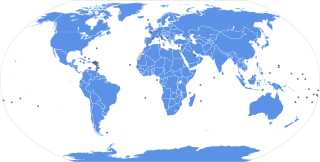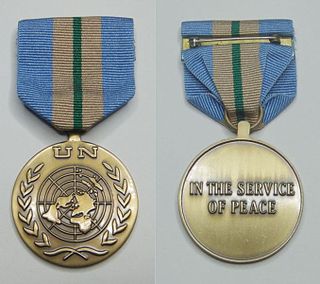Related Research Articles

The United Nations (UN) is an intergovernmental organization aiming to maintain international peace and security, develop friendly relations among nations, achieve international cooperation, and be a centre for harmonizing the actions of nations. It is the world's largest and most familiar international organization. The UN is headquartered on international territory in New York City, and has other main offices in Geneva, Nairobi, Vienna, and The Hague.

The United Nations General Assembly is one of the six principal organs of the United Nations (UN), serving as the main deliberative, policymaking, and representative organ of the UN. Currently in its 76th session, its powers, composition, functions, and procedures are set out in Chapter IV of the United Nations Charter. The UNGA is responsible for the UN budget, appointing the non-permanent members to the Security Council, appointing the Secretary-General of the United Nations, receiving reports from other parts of the UN system, and making recommendations through resolutions. It also establishes numerous subsidiary organs to advance or assist in its broad mandate. The UNGA is the only UN organ wherein all member states have equal representation.

The United Nations member states are the 193 sovereign states that are members of the United Nations (UN) and have equal representation in the UN General Assembly. The UN is the world's largest intergovernmental organization.
This article is about the demographic features of the population of Anguilla, including population density, ethnicity, education level, health of the populace, economic status, religious affiliations and other aspects of the population.
An UN number is a four-digit number that identifies hazardous materials, and articles in the framework of international transport. Some hazardous substances have their own UN numbers, while sometimes groups of chemicals or products with similar properties receive a common UN number. A chemical in its solid state may receive a different UN number than the liquid phase if their hazardous properties differ significantly; substances with different levels of purity may also receive different UN numbers.

A United Nations Medal is an international decoration awarded by the United Nations (UN) to the various world countries members for participation in joint international military and police operations such as peacekeeping, humanitarian efforts, and disaster relief. The medal is ranked in militaries and police forces as a service medal. The United Nations awarded its first medal during the Korean War (1950–1953). Since 1955, many additional United Nations medals have been created and awarded for participation in various United Nations missions and actions around the world.

Dangerous goods, abbreviated DG, are substances that when transported are a risk to health, safety, property or the environment. Certain dangerous goods that pose risks even when not being transported are known as hazardous materials.

The United Nations geoscheme is a system which divides 249 countries and territories in the world into six regional, 17 subregional, and nine sub-subregional groups. It was devised by the United Nations Statistics Division (UNSD) based on the M49 coding classification.
In mathematics, the Ulam numbers comprise an integer sequence devised by and named after Stanislaw Ulam, who introduced it in 1964. The standard Ulam sequence starts with U1 = 1 and U2 = 2. Then for n > 2, Un is defined to be the smallest integer that is the sum of two distinct earlier terms in exactly one way and larger than all earlier terms.
The UN numbers range from UN0001 to about UN3600 and are assigned by the United Nations Committee of Experts on the Transport of Dangerous Goods.
The following outline is provided as an overview of and topical guide to the United Nations:
Spying on United Nations leaders by United States diplomats was confirmed by a 2009 confidential directive from the United States Department of State directly instructing US diplomats to spy on top officials of the United Nations. The intelligence information to be gathered included biometric information and passwords and other authentication keys used in official communications. The directives were revealed as part of the United States diplomatic cables leak in late 2010. While spying by the US on the UN was not new, the directive's aggressive goals for information gathering and desire for use of regular diplomats in the gathering was, and caused a strain in relations between the US and UN.
References
- ↑ "Chapter I: Research and Special Administration". The Code of Federal Regulations of the United States of America. U.S. Government Printing Office. 1988. Retrieved 2015-11-23.